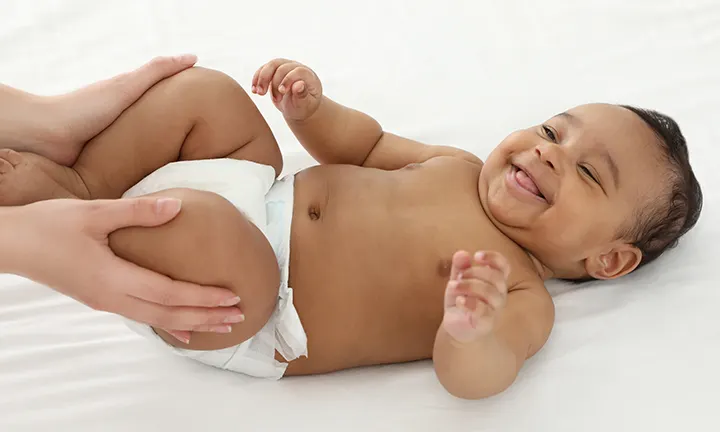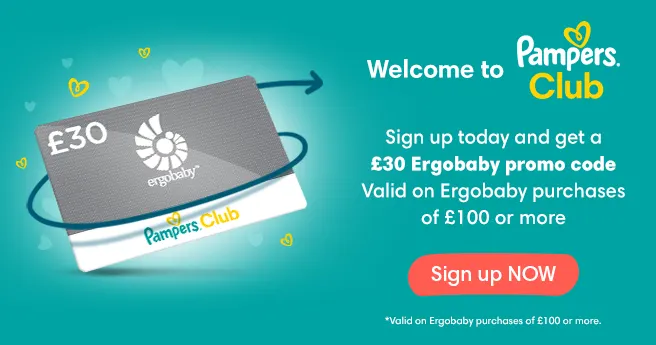Baby Massage – How to Get Started
Touch is an important way of communicating with your baby and, besides soothing your little one, massage can help strengthen your parent-child bond. Learn more about the potential benefits of baby massage, what kinds of massage oil and techniques could be suitable and how you can massage your newborn in the comfort of your own home.
What Is Baby Massage?
Baby massage is a soothing therapy that involves gently touching and stroking your baby in a way that helps him or her feel calmer and more relaxed. Beyond helping to communicate your love and care, massage has all sorts of other benefits, for example a tummy massage can be good for your baby’s digestion, helping to ease or prevent colic, constipation and wind. It’s also a great way of bonding with your little one and helping you to build up confidence in handling your baby.
What Are the Benefits of Baby Massage?
So, is it good to massage your baby? Experts believe it is. The benefits of baby massage can include:
Parent-child bonding
Soothes and calms your baby
Good for sleep
A tummy massage can be good for digestion, helping to prevent or alleviate wind and constipation
May help prevent or ease colic
Stimulates circulation, boosting the supply of blood to muscles and tissue
Releases natural painkillers known as endorphins
Encourages weight gain.
How Do You Give your Newborn a Massage?
With just a little bit of prep and some basic massage techniques, you are all set to start massaging your baby. Follow these five easy steps:
Pick your location. Find a warm, calming environment, like a quiet room or a shady spot outdoors on a sunny day. The massage can take place on the floor or the ground, on a bed, or on the changing table. But be sure not to leave your baby unattended on a high surface – not even for a second – as he or she could roll over and fall. Always keep a hand on your baby during the massage.
Get your baby calm for the massage. You might consider massaging your baby after a bath when he or she is feeling relaxed, but you can choose any other time too when both of you are feeling calm. Get your oil or skin cream ready if you're planning on using it. Make sure it’s suitable for your baby’s skin – if you’re in any doubt ask your health visitor for advice first. Once you’re ready to begin, undress your baby (leaving the nappy on, if you wish) and place him or her in your lap or in front of you on a blanket or soft towel.
Pay attention to your touch. Massage your baby with gentle strokes, keeping your hands flat so as much of your hand as possible is in contact with his or her skin. If your baby is still very little, use your fingers instead of your whole hand. As your baby gets older and more accustomed to the routine, you can gradually increase the pressure or firmness of your touch.
Be calm and communicative. Make sure you’re calm and comfortable yourself before starting the massage. It may help to sit or kneel on a soft mat or cushion. Throughout your baby’s massage, stay connected to your baby by quietly talking, singing a song or telling a story. Pay attention to how your infant reacts to your touch and adjust the rhythm and pressure of the strokes in response to his or her cues. If your baby doesn’t seem to be enjoying it – for example if he or she turns away from you, fidgets or seems unhappy – it’s time to stop. You can always try again another day.
Move outwards from the body. Unlike the massage technique often used for adults, your massage strokes should move outwards from the body. It’s a good idea to practice massaging each part of the body separately before trying this simple whole-body massage:
Chest. With your baby on his or her back, stroke gently from the chest towards the arms and legs, with your hands (or fingers, if your baby is still very small) as flat as possible.
Arms. Stroke down the arms with ‘wringing’ motions, trying to gently stretch them out.
Tummy. When massaging the tummy area, first use circular movements in a clockwise direction. Then, gently massage the soft area on your baby’s side, stroking downwards from the side of the body down towards the tummy area.
Legs. Gently straighten out the legs, stroking down from the hips towards the feet. You could do them one at a time, or both simultaneously by encircling each leg with one hand. Massage the legs again using the same gentle ‘wringing’ movements you did with the arms.
Fingers and toes. Spread the hands out and massage the base of the fingers in your baby’s palm. Gently pull the fingers apart and massage each one separately. Do the same with the toes, massaging the base of the toes in the sole of your baby’s foot. Give each toe a gentle pull.
Leg stretch. Hold the ankles and push them up towards your baby’s shoulders, allowing the knees to bend outwards. Let your baby guide this movement, don’t force it.
Back. Turn your baby over onto his or her tummy. Massage from the shoulders to the buttocks in single strokes with your hands (or fingers) as flat as possible.
Bottom and backs of legs. With the nappy off, use the heel of your hands to gently massage your baby’s buttocks with a circular motion. Continue down the backs of the legs to each foot with strokes of the hand. Hold your baby’s ankle and gently stretch his or her heel towards the buttock, then repeat with the other leg.
If your baby has any special medical issues, be sure to check with your doctor, midwife or health visitor before starting to massage.
Baby Massage Courses or Classes
If you feel hesitant about starting infant massage, or if there’s anything you’re unsure about, talk to your midwife or health visitor. Besides offering advice about safe massaging techniques, they may also be able to tell you about baby massage courses or classes that are available in your local area.
When Can You Start Massaging Your Baby?
You can start massaging your baby as early as you like. Just be sure to be extra gentle with a newborn.
Here are some tips on choosing the right times to massage your baby:
Pay attention to your baby’s moods. If your infant seems calm and relaxed and not too sleepy, it’s probably okay to try giving him or her a massage. If your little one seems fussy or isn’t in the mood to be handled, it might be best to skip the massage for now.
Choose a time that’s good for both of you. It’s up to you and your baby when and how often you do this activity together. You may decide to massage your baby in the evening, for example, as part of his or her bedtime routine.
Don’t massage your baby...
within an hour after a feed
if your baby has a high temperature
if your baby shows any other symptoms of illness
in the 48 hours after your baby has had an immunisation
if your baby has a visible skin irritation like a rash
just after your baby wakes up.
Which Oil is Best for Baby Massage?
This is a personal preference. You may prefer to keep things natural and not use any oil at all. On the other hand, you might like to use a massage medium such as an oil, or perhaps a cream that you already have on hand for your baby’s skin care to help reduce any friction created between your hands and your baby’s delicate skin. Some experts recommend using cold-pressed vegetable or fruit oils, which are readily available from chemists or health food shops. Oils intended for cooking aren’t recommended because they’re usually subjected to a refining process that use high temperatures and chemicals that change the natural properties of the oil. Here are some suggestions for oils and other massage mediums you could try:
Grapeseed oil. A light oil that leaves the skin with a satin sheen but isn’t greasy.
Rapeseed oil. Contains vitamin E to nourish and soften the skin.
Calendula oil. This oil can help replenish the moisture of dry or cracked skin.
Apricot kernel oil. A mild oil that could be suitable for sensitive skin.
Coconut oil. Unrefined coconut oil can have a sweet aroma.
Baby massage oil or cream. Commercially available massage oils or creams might be suitable for your baby but added perfumes may irritate sensitive skin. It’s safest to check with your health visitor first if you’re unsure about which brand or product to use.
Skin cream you already use on your baby. If your baby has a skin condition like eczema, it may be best to use whatever cream or ointment has been prescribed or recommended for it by your doctor or health visitor (except steroid creams). Check with your health visitor or doctor if you’re unsure whether a cream is suitable.
Before using the oil for the first time, test it to gauge the reaction on your baby’s skin a few hours before the massage. Do this by applying a tiny bit to a small area of his or her skin and wait to see if there’s a reaction. If there is, stop using the oil and consider trying another type of massage medium or skipping it altogether.
The Bottom Line
Massage is a great way to soothe and bond with your baby. You might find that you enjoy this time together just as much as your little one does. Choose a time when your baby seems calm and relaxed but awake and alert – and you never know, it could turn into a routine that your child comes to love and expect.
The information in this article is based on the expert advice found in trusted medical and government sources, such as the National Health Service (NHS). You can find a full list of sources used for this article below. The content on this page should not replace professional medical advice. Always consult medical professionals for full diagnosis and treatment.
Read more about Newborn Baby
Join Pampers Club and get:





